Portrait of Dr Ephraim Bueno
The 'Portrait of Ephraim Bueno,' created by Rembrandt between 1645 and 1647, portrays the Jewish physician, poet, and translator Ephraim Bueno of Portuguese descent. Characterized by its intense focus on Bueno's facial expressions and the dramatic use of chiaroscuro, this work exemplifies Rembrandt's exceptional ability to reveal the depth of character through paint. It serves not just as a portrait but as a preparatory study for a print, demonstrating Rembrandt's innovative approach to the genre.
1645 - 1647
About the Artwork
Ephraim Bueno was a prominent figure in the Jewish community during the 17th century, known for his contributions as a physician, poet, and translator. His connection with Rembrandt suggests a vibrant social network consisting of intellects and artists. Commissioned likely within this circle, the portrait captures not just Bueno's likeness but immerses him in a world where art and scholarship thrive. Rembrandt's choice to delineate Bueno's face with such emotional intensity and masterful use of light and shadow speaks to a profound respect and understanding of his subject, making the artwork a significant artifact of cultural exchange and artistic legacy.
Did You Know
Liked what you see? Add it to your collection.
Enjoyed reading? Share it.
... continued
Subject
The portrait is of Ephraim Bueno, a Jewish physician, poet, and translator from Portugal. Bueno was likely part of Rembrandt's circle of friends.
Purpose
The portrait was painted as a preparatory study for a print, which is why Rembrandt focused primarily on the face and the play of light and dark. This focus on the face is characteristic of Rembrandt's attention to detail in capturing the essence of his subjects.
Technique
The painting features coarse brushstrokes for the clothing and hands, indicating that these aspects were less important for the purposes of this preparatory study. The emphasis on the face highlights Rembrandt's mastery of capturing expressions and the interplay of light and shadow.
Current Location
The portrait is part of the collection at the Rijksmuseum in Amsterdam, Netherlands.










